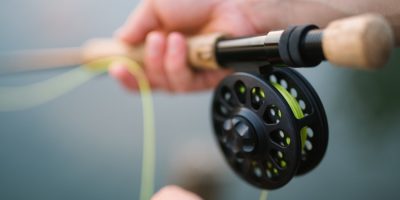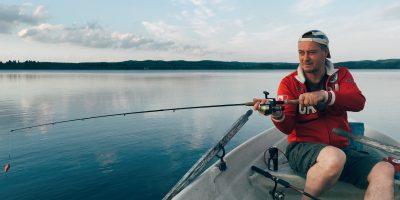Kayak fishing is a popular sport and pastime among anglers. However, big catches aren’t always promised. But to ensure that you’ll have the best time in the water, you must carry the best depth finder for kayak use. This portable fish finder lets you see where the big catches are located and its depth. Instead of blindly casting a line and waiting, you can target right where the fishes are hiding.
In this post, I reviewed five of my tried-and-tested depth finders. I’ve taken all of these a lot during my kayak fishing trips, and I vouch for its performance. See which one suits your preference and budget.
| DEPTH FINDER | BRAND | EXPERT RATING | CHECK PRICE |
|---|---|---|---|
 | Our Top Pick! Deeper PRO+ Castable Depth Finder for Kayak | Check Price | |
 | JOYLOG Smart Sonar Fish Finder | Check Price | |
 | LUCKY 1108-CT Depth and Fish Finder | Check Price | |
 | Venterior Portable Fish Finder | Check Price | |
 | LUCKY FFW-718 Depth Finder | Check Price |
Best Depth Finder For Kayak – Top 5 Picks
OUR #1 CHOICE
OUR TOP PICK: Deeper PRO+ Castable Depth Finder for Kayak

Product Name: Deeper PRO+ Castable Depth Finder for Kayak
Product Description: If you're looking for the best depth finder for kayak, I highly recommend the Deeper PRO+. This is a castable depth finder that syncs to your chosen Android or iOS device. You can mount your smartphone on your rod, so you can easily monitor the pings that come from the depth finder. Moreover, this is a convenient choice for kayak use. There's no need to install a monitor device on your kayak since you can easily connect this to your rig. You can just mount your phone on the kayak, so you can cast your line without worrying about your device. Aside from that, this depth finder has built-in GPS that lets you create bathymetric maps even if you're on the shore. It doesn't have cables, and no mounts are needed to use this depth finder.
Offer price: $$$
Availability: InStock
-
Range
-
Connectivity
-
Ease of Use
-
Value for Money
Overall
Summary
I also like its ice fishing functionality that lets you zoom and separate targets. It boasts rock-solid connectivity with no internet connection needed. You can scan up to 260 feet at a maximum cast distance of 33 feet.
The Deeper PRO+ also has dual beams (15 and 50 degrees) and only takes 15 seconds per scan. You can readily see the map depth, structure, and surrounding vegetation. Most of all, it lets you target where the fishes are located.
Using the Deeper App, you can store all your scanned data on the cloud. You can access the data using any computer with Lakebook. You can even manage the data based on the location where you fish. It’s pretty nifty if you’re going to ask me.
Pros
Castable, no wires or mounts
Scans up to 260 feet deep
Connects to the Deeper app and Lakebook
Cons
It doesn’t come with a reflective cap for added visibility, but not a biggie
RUNNERS-UP
JOYLOG Smart Sonar Fish Finder
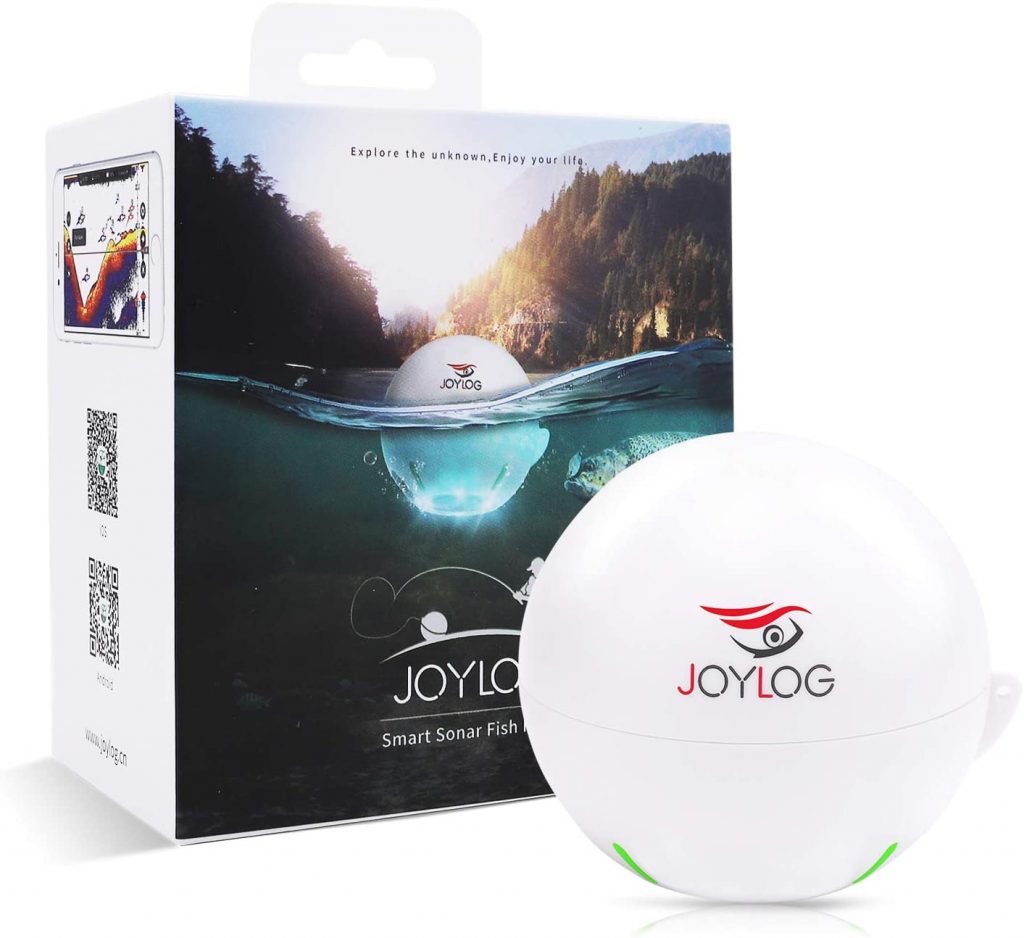
Another depth finder I recommend is the JOYLOG Smart Sonar. This is a portable fish finder similar to what Deeper offers. It’s also castable and can be connected to your mobile device. This also supports ice fishing if you’re not getting into your kayak.
Moreover, the JOYLOG depth finder has digital sonar imaging that lets you scan up to 131 feet below. It also has an automatic start-stop function aside from its green-attracting fish lamp. The sonar will start once it lands on water and shut off 30 seconds after being reeled back.
I also like that you can use it in 26 operating languages while enjoying its high-speed wireless connection. As long as you stay within the 164-feet range from the depth finder, you’ll receive accurate and real-time scans.
Aside from that, this depth finder works at temperatures between -20C and 70C. It has a detection angle of 30 degrees, but no other option like the Deeper.
Take note that this works via Bluetooth at a sonar frequency of 125 kHz. It’s 2.56″ x 2.38″ in size, which is very compact and light for just 0.19 lbs. It’s easy to cast since it also has a built-in loop for your rig.
Overall, this is a reliable range finder for kayak fishing. There are no wires or mounting needed, which frees up space on your kayak. It also works up to 10 hours for every charge.
LUCKY 1108-CT Portable Depth and Fish Finder
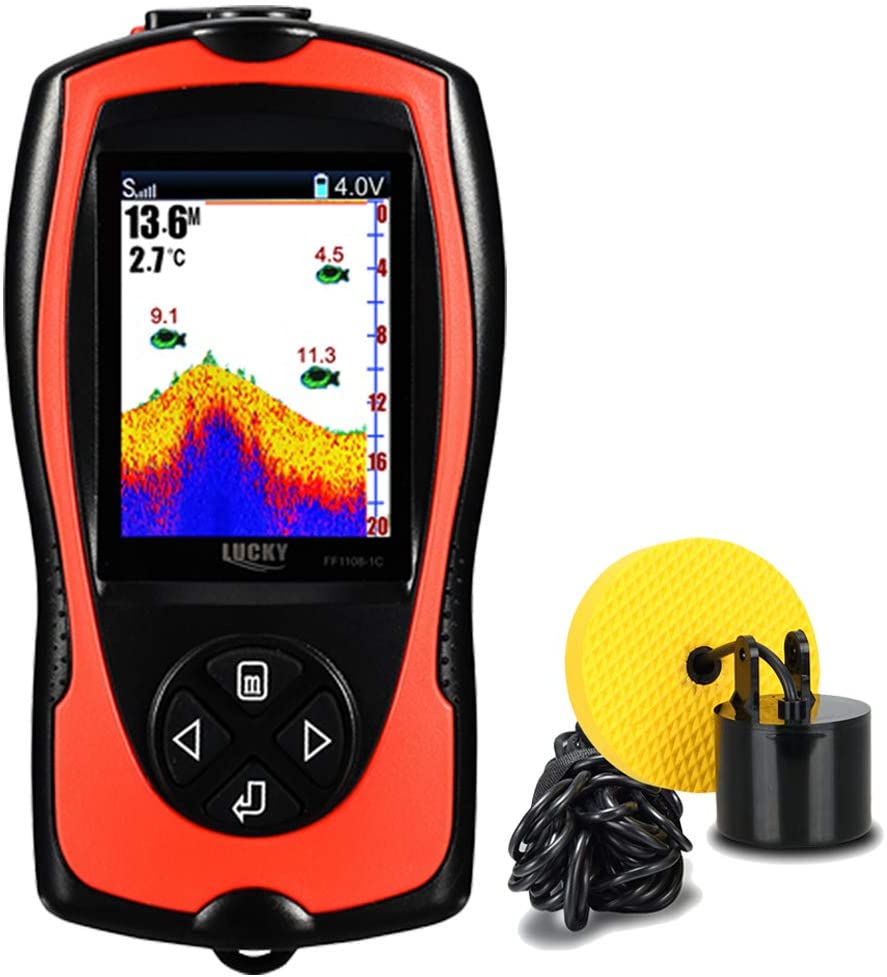
If you’re looking for a depth finder with a portable display, you should consider the LUCKY 1108-CT. This is a transducer that you can easily mount on your kayak. It comes with a transducer device and a wired sonar.
Take note that this requires wired operation but for a very good reason. Since it’s wired, this offers up to 328 feet of scan detection. It also works for up to 26 feet of wired operation at a scan angle of 45 degrees at 200 kHz.
Moreover, this package includes a portable fish finder with a 2.4″ TFT color display. It will show you the water depth, underwater contours, temperature, and location of the fishes. It’s very intuitive, with simple controls that even beginner kayak anglers can easily understand.
For each charge, the depth finder can work for up to five hours. You can also adjust the brightness of the display if you want to save power.
Aside from that, this device will let you use a depth alarm and fish alarm to notify you where to take your kayak. Whether you’re ice fishing, lake fishing, or shore fishing, this depth finder is a topnotch choice.
This depth finder works at -10 C to 50C, which is suitable for most fishing conditions. I also like that the sonar comes with a yellow cap that adds visibility while on the water.
Venterior Portable Fish Finder
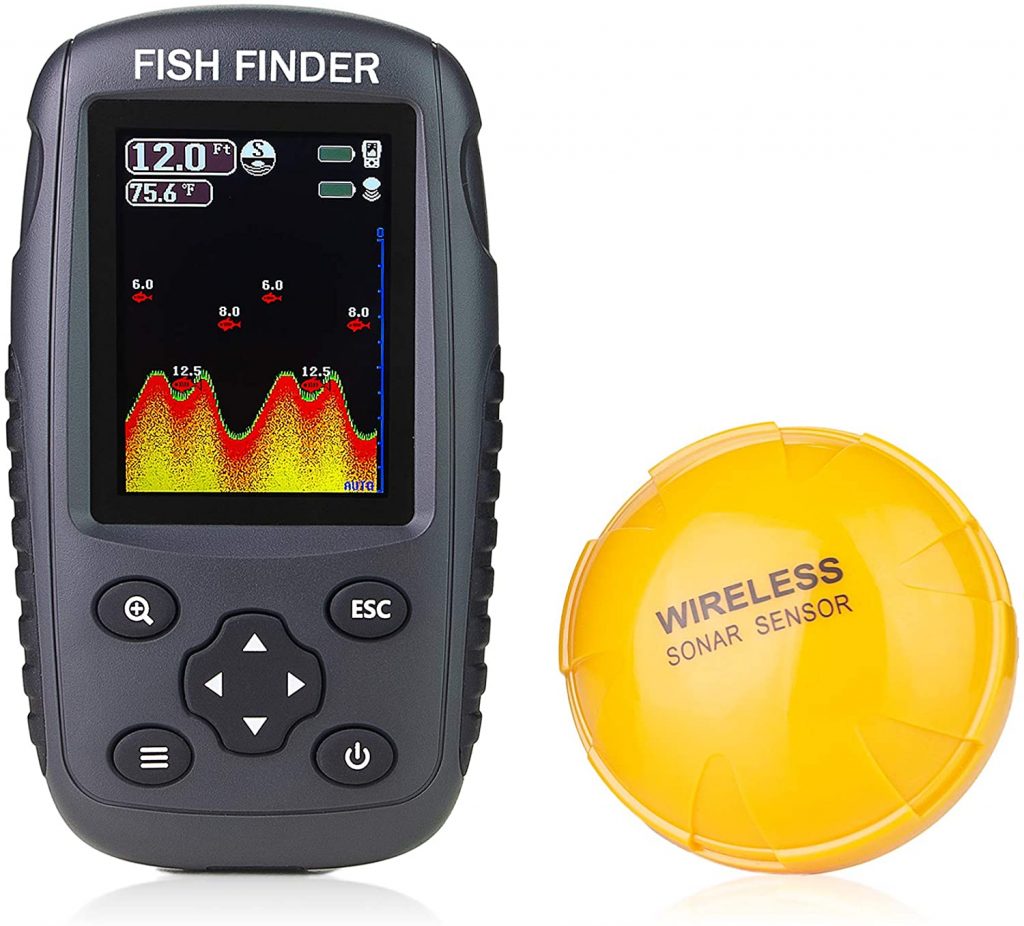
Another fish finder you can consider is this one from Venterior. It comes with a fish finder controller and a sonar sensor.
The depth finder controller has a wireless operation complete with the features you need to find the best catches from your kayak. The fish finder’s TFT display shows the water depth, bottom contour, fish depth, and water temperature. You’ll also see the depth scale and range for better knowledge of where fishes are located.
On the other hand, the sonar sensor is castable, so there’s no need to worry about heavy transducer cables. It’s the perfect choice for kayak fishing on the lake or river. And for the best results, you can use the simulation mode to see how well you’re going to target a fish.
Aside from that, this depth finder has a maximum range of 131 feet below with a sonar beam angle of 105 degrees. Just note that it has a maximum wireless connection of up to 262 feet, which is probably the farthest I’ve seen on a wireless depth finder.
Moreover, the sensor has two small holes where you can tether your fish line. There’s no need to bore holes or rig this up. Just tie it to your line, cast, and start scanning for fishes. You can also wear the receiving host around your neck using the provided neck strap.
Also, this depth finder is protected by a two-year warranty. For this price range, this is already a good catch.
LUCKY FFW-718 Depth Finder
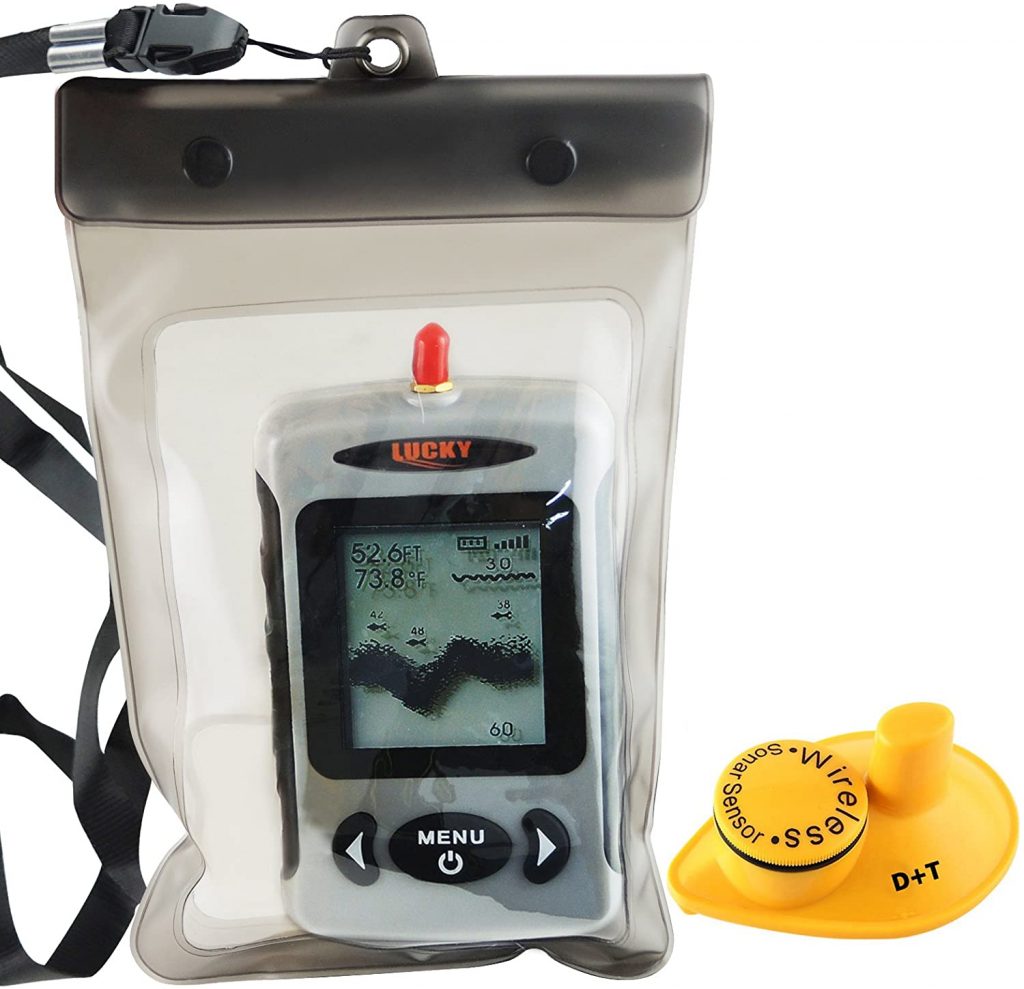
If you’re on a budget, my best pick is the LUCKY FFW-718. This has a depth range of up to 135 feet and a wireless operation range of 394 feet. This works on a wireless frequency of 433 MHz and a sonar frequency of 125 kHz.
The receiver of this depth finder works in three languages: English, Deutsch, and Russian. It’s programmed with an adjustable sensitivity level and audible fish and depth alarms.
Moreover, this has a 90-degree scan beam angle with a live display update. This will let you see the bottom contours and zoom at it to identify specific depth ranges.
Meanwhile, the sonar is housed inside a yellow floater. It already has a hole where you can connect it to your line.
I also like that this comes with a waterproof pouch that you can wear around your neck. So even if your kayak gets splashed with water, the receiver won’t be ruined.
The only thing that could be a downer for some is the black and white display. But for this price range, I think that’s already a reasonable bargain. Besides, the depth finder works just the same as colored ones.
How to choose the best depth finder for kayak
If you’re looking for the best depth finders for kayak, you should look for the following aspects:
✔️Range
One of the first things you should look for when choosing a depth finder is its range. For this part, you’ll check for two aspects: the depth range (vertical) and the connection range (horizontal).
For the depth range, you have to consider the topography of the water where you’ll go kayak fishing. Most depth finders in the market are available in 100 to 250+ feet in terms of range. This means that the sonar sensor can detect underwater features at such depths. The deeper the water is, the more powerful your depth finder should be.
Moreover, you should check the connection range of the depth finder. This refers to how far the sonar can go before it loses contact with the receiver. This varies widely, but most models I’ve used before range between 50 to 300+ feet.
✔️Frequency
Another important thing that beginner anglers miss is the frequency of the depth finder. It’s available in single, dual, and multiple frequencies, which affects how well the depth finder will perform on the water.
For shallow waters, a higher frequency of around 190 to 200 kHz is the ideal choice. Meanwhile, deeper waters can make use of lower frequencies.
Some depth finders allow you to switch between frequencies to suit the water where you’re going to fish. However, this feature is commonly found in commercial options. Nevertheless, if the depth finder is made for kayaks, it should work seamlessly on rivers and lakes.
✔️Wireless vs. wired
Another thing you should consider is whether you’ll get a wireless or wired depth finder. A wireless depth finder is easy to use because the sonar can be cast while attached to your line. This lets you scan the area right where your hook landed.
On the other hand, wired depth finders have their advantages. It tends to have a higher depth range, although the connection range is limited. Nevertheless, it’s known for reliability, although you’ll have to get used to the heavy transducer lines.
✔️Smart vs. traditional
Traditional depth finders are bundled with a receiver where you can monitor the scanned data. You can mount this on your kayak or wear it around your neck with a strap.
Meanwhile, depth finders like those from Deeper and JOYLOG don’t need a separate receiver. You can connect the sonars to a smartphone app, making your phone an instant receiver. This is a more convenient option for those who don’t want to fiddle with a small display and limited buttons.
Both of these depth finder types work, so it’s up to you which you find more convenient to use.
✔️Beam angle
The beam angle of the depth finder refers to the invisible cone-shaped area that the sonar scans. Also known as the cone angle, this varies widely among depth finders. It can be fixed or interchangeable between narrow and wide angles.
So which one should you get? If you the most accurate readings, a narrower beam angle is a perfect choice. However, since it scans a narrow area, you’ll have to conduct multiple scans to survey a larger underwater portion.
You can also opt for wider beam angles if you want to cover a large area at once. However, this is at the expense of sensitivity. Still, the accuracy is pretty decent, even if the sensitivity is spread out.
✔️Connectivity
The sonar sensor must connect solidly with the receiver. This is regardless if you have a separate controller device or using your smartphone.
Make sure that the sonar doesn’t break connectivity because this will defeat the purpose of using one. The only way to check this is by trying it on the water and seeing if the scans are accurate and reliable.
✔️Display
If you are purchasing a depth finder with a separate controller, you should check its display quality. Make sure that it’s easy to read. You should also check the features it projects, which could include but are not limited to depth ranges, fish locations, underwater contours, battery power, and so on. Some depth finders allow you to zoom in to an area to see a more accurate reading.
✔️Power
Lastly, check the battery power of the depth finder you’re going to get. A unit that can run for at least three hours per charge is already decent. Others can work up to 10 hours, which is a great choice for anglers who love spending lots of time fishing in their kayak.
Final words
Are you having difficulties getting a decent catch lately? The best depth finder for kayak will be a big help. It will let you detect the spot where fishes are located, so you will have better chances of hooking a big catch. Just make sure that your depth finder has the right features and range to suit your next kayak fishing trip.

